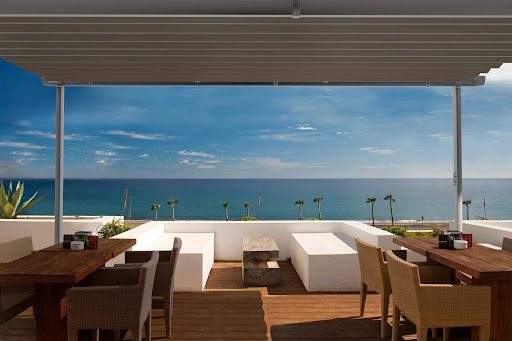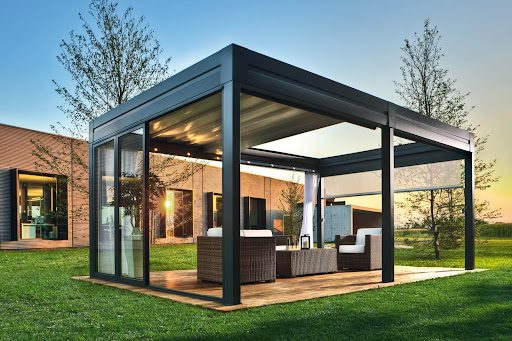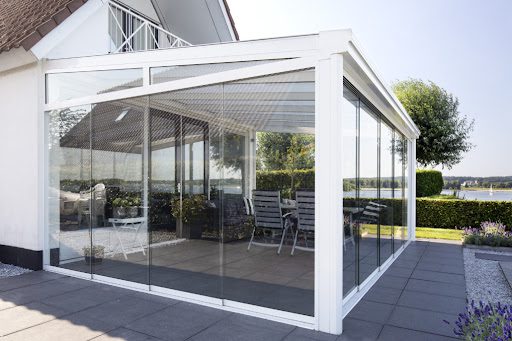Are you planning on purchasing a retractable awning for your home or business, but you’ve heard that you might need a special permit to build outdoor structures? If so, you’ve come to the right place where you can find all your answers.
I hope I can shed light on planning permissions. Do you need one, and how can you get it so you can continue with your project of creating your dream outdoor living area?
Before we begin, it’s essential to clarify that the necessity for permits and planning permissions can significantly vary depending on the country you are located in. That’s why I decided to focus on installing a retractable awning in the USA and the specific regulations you’ll need to abide by.
So hopefully, by the end of this blog post, you’ll have a better understanding of what you should consider when installing an awning. In addition, you’ll know whether you need planning permission and what is the right course of action in your case.

Do I need planning permission to install a retractable awning on my property?
Before we begin with lengthy explanations, what-ifs and whatnot, let’s clarify the meaning of a building permit.
Building permits or planning permissions are official written statements, typically issued by a local council or a county government. These statements authorize you to construct, expand or remodel a structure on your property. Are you wondering why you need this? After all, it’s your property, right?
While that might be true, a building permit aims to ensure that your project complies with regulatory requirements and safety precautions which can vary. Examples include earthquakes, zoning codes, water lines, electrical wiring, etc.
Regulations also vary depending on the type of building and project, as residential owners must abide by different rules than owners of commercial properties. I’ll need to comment on each type in separate subtopics.
Which projects require planning permission?
You’ll first need to consult with the local council or government agency, as each region and municipality has different requirements. The reason why rules vary between cities is mainly because of climates, topography and safety.
For example, one area can be susceptible to fires in the summer, while another may suffer from hurricanes and tropical cyclones during certain months. A third may be known to regularly suffer earthquakes, so safety issues will be different there.
All of the above should give you a clear idea of why building permits are essential.
So after we got all that cleared up, let’s see some examples of projects that will probably require a permit:
- Any type of structural change or expansion of an existing structure
- Building extra roofs or re-roofing your existing ones.
- Replacing windows or doors.
- Demolition of existing building parts or sections
- Constructing new walls or removing existing walls.
- Changing and renewing in-house piping.
- Building a deck or a shed.
Which projects do not require planning permission?
It’s imperative to note that not all home improvement projects require a building permit, so don’t get discouraged.
Here are some instances when you won’t need local council approval:
- Adding indoor furnishings
- Adding a fresh coat of paint to the walls
- Renewing the driveway
- Building a small fence
- Installing floor coverings

What are standard practices?
Some general rules of thumb can help you navigate the process when installing retractable awnings on your property.
If you own a residential property, you most likely won’t be required to acquire a permit for installing an awning. Even less so is a retractable roof, as it’s a semi-permanent structure. However, if your extended canopy overreaches to a neighboring property or a public area, you’ll need to have it signed by a local authority.
On the other hand, if you’re the owner of a commercial property, things might get more complicated. But let’s get into more detail.
For residential property owners
Typically, you won’t need to get written permitted development rights to install a retractable awning at your house. However, don’t stop reading just yet because there are still a few things to consider.
First off, installing a residential patio awning does not require approval as long as it doesn’t cross your property’s boundaries and reach a neighboring or public area. It also shouldn’t affect your neighbors in any way – e.g., causing rainwater to run directly into their yard or casting undesired shade onto their greenery.
On another note, consider if your retractable awning creates more usable space for your property outside its given boundary lines. To clarify, imagine you want to mount an awning to your house to cover your backyard. As long as your residential awning extends within the property boundary, it’s all well.
However, you’ll need a permit if it expands into a public or another private area and adds to your square footage.
For commercial property owners
As opposed to those in residential homes, commercial awnings will most probably require full planning permission to be approved by a local authority. That is if you plan to install an awning at the front of your shop or in your restaurant’s garden.
The main concern with such installations is their extension into public areas causing potential health and safety hazards for passing pedestrians. In such cases, there are special requirements for installation. Examples are how many feet above the ground the valance should be and how far away from the building the projection should reach.
Of course, there are exceptions to this rule. Let’s look at a commercial building with an adjacent outdoor area within its boundaries. For example, covering an outdoor backyard or a patio to increase seating places in a bar, restaurant, or a café may not need special approval.
Another thing to consider if you want a retractable awning for your business is its feature branding. Awnings are a stylish way to display your logo and values and make your brand recognizable. However, there might be specific advertising regulations that you need to follow when customizing your awning.
Unusual states of affairs
Unfortunately, things are often not so black and white. There are some unusual circumstances that need to be addressed. You should consult or visit a local council’s website in such cases.
These situations include, but are not limited to the following:
- Historic homeowners
- Members of the homeowners’ association
- Condo owners
- Connecting townhouse owners
Check if there are special appearance consistency requirements or board approval requirements if you fall under any of the above situations. In a joint townhouse association, some expenses are shared, and if installing or maintaining an awning is one of them, you need the support of your neighbors.
What aspects should you consider?
Despite the standard practices described above, there are a few things to consider regarding official permits from a relevant authority when installing a retractable awning on your property.
Where are you going to install the awning?
One of the more critical things to consider is where exactly you will install the awning. Is it going to be mounted on a wall or a soffit? Will the surface be strong enough to hold the weight?
In addition, when the awning is fully extended, is it still within your home or business’ boundaries or does it cover a neighboring or public area? If it starts raining, will the water potentially run toward the outside of your property because of the structure?

What type of retractable awning are you planning to install?
“Awning” is a general term encompassing many different shading structures. A fixed awning is considered to be a permanent structure that will require authorization. On the other hand, retractable awnings are considered semi-permanent structures, but there are various types.
Retractable pergola
Outdoor pergolas with retractable roofs are typically larger and require additional support posts to cover larger outdoor areas and support heavy waterproof canopies or louvered roofs. More often than not, you’ll need to check with your local county if you need planning permission to proceed with your project.
Retractable awning
Installing a retractable awning doesn’t require you to build any additional structures. You only need a solid surface to mount on, such as a wall, soffit or roof. It’s almost certain that you won’t need a permit to install one.
However, consider how far the projection will extend before proceeding with such a project and ensure it’s within your property.
Manual or electric awning?
Although it doesn’t have to do with building permits, choosing a motorized retractable awning might require you to abide by specific safety regulations issued by the local authorities. In general, installing a manual top would spare you the extra thought.
Are you planning to enclose the space?
Suppose you’re a home or a business owner. You might want to enclose the entire outdoor area by installing a pergola or a sizeable retractable awning and adding semi-permanent walls. Such walls may be sliding glass doors, etc.
If that’s your plan, you should check local regulations and see if enclosing the space will cost you extra time and effort.

How do I get planning permission?
It’s time to get to work. How do you get a building permit if you need one? There are a few steps to get through to obtain permission to install a retractable awning.
Step 1: Complete a permit application
The first step is to complete a permit application. The entire plan for your future project must be prepared and the corresponding maps, drawings, etc. must be applied. If you work with a contractor, he’ll probably have it ready to submit.
The plan must clearly show that you won’t interfere with any public areas. When installing an awning on a high street building, you have to consider the area the structure will cover and ensure that it complies with safety regulations.
Step 2: Schedule an appointment with the local authority
You must complete this step in advance, especially if you have a deadline for your project. Remember that approval of your plan might take anywhere from several days to several weeks. Schedule an appointment in advance, with enough time for review and decision.
Step 3: Get the permit before you proceed with your plan.
You must get the permit before beginning any construction, as the consequences can be dire. You risk a fine and the safety of your neighboring area and other people.
Step 4: Schedule your inspections
Installing a retractable awning is far less complicated than building an entirely new permanent construction. That’s why you won’t need to undergo regular inspections that oversee how your project is going.
However, if you had to get planning permission and it was approved, you’ll have to schedule at least one inspection after you finalize the installation. That’s to ensure that all safety requirements are met and the structure doesn’t present any hazards and to obtain final approval.
In special circumstances
In the case of condos or joint townhouses, you’ll also need to contact the associations’ board members with all the relevant information, so they can provide written approval. Information should typically include materials, colors, and sizes, as well as insurance and installation companies.
Why is it a terrible idea to install an awning without planning permission?
If you discover that your project requires planning permission and decide to continue it without acquiring one, you’ll have to face the consequences. There are different consequences in different countries, but they are all similar in nature.
As you might have already guessed, one thing that could happen is that you get charged with a fine. The fine will vary according to the size of your project and the particular violation. Another possibility is that you will have to abandon the project or even demolish it.
If you have a residential insurance policy, read the terms and conditions carefully. You’ll often find a clause stating that the provider will not cover any injuries or damage caused by unpermitted work.
If not for anything else, at least get planning permission to be sure your project, property, family and friends will be safe. Small details count, and any mistake can lead to serious consequences.
I highly recommend abiding by all local and county ordinances, even if it seems to be taking a long time or is too costly for you.

Summary
Together, we’ve reviewed a lot of information. To summarize, let’s see common cases in which you need a permit and when you don’t need a license.
When do you need a permit:
- When the awning will cover public space or area.
- When it will pass into a neighbor’s property.
- Property that needs to preserve its original appearance (for example, historic homes).
- If you are enclosing outdoor space (e.g., glass rooms and extensions).
- If you want to install an awning on a condo or a townhouse.
- If you plan to use it for advertising and branding purposes.
When do you not need a permit:
- For small projects without major structural changes.
- Residential awnings that do not interfere with public or neighboring areas.
- If you are not planning to enclose outdoor space.
- If the awning does not add to your overall outdoor square footage.
